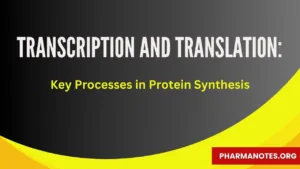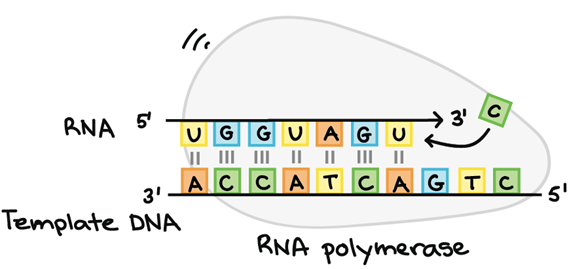Transcription and Translation

Transcription and Translation
Objective
• At the end of this lecture, student will be able to
– Describe the steps involved in RNA synthesis (transcription) and protein synthesis (translation)
Gene to protein
• A gene is used to build a protein in a two-step process
RNA Synthesis (Transcription)
• Process of synthesis of RNA that takes place on a DNA template
• First step of gene expression, in which a particular segment of DNA is copied into RNA (mRNA) by the enzyme RNA polymerase
• Genetic information stored in DNA is expressed through RNA
• For this purpose one of the two strands of DNA serves as a template(non-coding strand or sense strand) and produces working copies of RNA molecules
• Other DNA strand which does not participate in transcription is referred to as coding strand or antisense strand or non-template strand
• In the newly made RNA, all of the T nucleotides are replaced with U nucleotides
• RNA polymerase is the main transcription enzyme
• Transcription involves 3 different stages
• Initiation
• Elongation
• Termination
• Before transcription can take place, the DNA double helix must unwind near the gene that is getting transcribed
• Region of opened-up DNA is called a transcription bubble
• Transcription begins when RNA polymerase binds to a promoter sequence near the beginning of a gene
• RNA polymerase uses one of the DNA strands as a template to make a new, complementary RNA molecule
• Transcription ends in a process called termination
Transcription initiation
• To begin transcribing a gene, RNA polymerase binds to the DNA of the gene at a region called the promoter
• Transcription starts at the promoter site of DNA
• Each gene has its own promoter
• A promoter contains DNA sequences that let RNA polymerase attach to the DNA
• RNA polymerase consists of core enzyme and sigma factor
• Sigma factor recognizes the promoter sequences
• Once the transcription bubble has formed, the polymerase can start transcribing
Elongation
• RNA polymerase binds with the promoter region, the sigma factor is released and transcription proceeds
• RNA is synthesized from 5′ end to 3′ end (5’͢ 3′) antiparallel to the DNA template
• Sequence of nucleotide bases in the mRNA is complementary to the template DNA strand
• lt is identical to that of coding strand except that RNA contains U in place of T in DNA
• During elongation, RNA polymerase moves along template strand, in the 3′ to 5′ direction
• For each nucleotide in the template, RNA polymerase adds a matching (complementary) RNA nucleotide to the 3′ end of the RNA strand
Termination
• Process of transcription stops by termination signals
• Termination is signalled by a sequence in the template strand of DNA molecule, a signal that is recognized by a termination protein, Rho (ρ)factor (in prokaryotes)
• At specific termination sites, new RNA chain is released
• After termination, core enzyme separates from DNA template and core enzyme binds with sigma factor and takes part in formation of new RNA molecule
• After end of termination, Rho (ρ)factor dissociates RNA and this factor is again recycled
Protein Synthesis (Translation)
• Biosynthesis of a protein or a polypeptide in a living cell is referred to as translation
• mRNA is translated into proteins with the help of ribosomes and tRNA
• In mRNA, the instructions for building a polypeptide are RNA nucleotides (As, Us, Cs, and Gs) read in groups of three called codons
• Three nucleotide (triplet) base sequences in mRNA that act as code words for amino acids in protein constitute the genetic code or simply codons
• Each of 20 amino acids is coded by one or more of these triplets
• Three codons UAA, UAG and UCA do not code for amino acids
• They act as stop signals in protein synthesis
• These three codons are collectively known as termination codons or non-sense codons
• Codon AUG that specifies the amino acid methionine acts as chain initiating codon
• Genetic code is universal – same codons are used to code for the same amino acids in all the living organisms
• Genetic code
• Ribosomes are structures where polypeptides (proteins) are built
• Each ribosome has two subunits, a large one and a small one, which come together around an mRNA
• Transfer RNAs, or tRNAs, are molecular “bridges” that connect mRNA codons to the amino acids they encode
• One end of each tRNA has a sequence of three nucleotides called an anticodon, which can bind to specific mRNA codons
• Other end of the tRNA carries the amino acid specified by the codons
Step 1- Initiation
• In initiation, the ribosome assembles around the mRNA to be read and the first tRNA
• mRNA transcript with start codon AUG attaches to the small ribosomal subunit
• Small subunit attaches to large ribosomal subunit
Step 2 – Elongation
• As ribosome moves, two tRNA with their amino acids move into site A and P of the ribosome
• tRNA binds to matching codon
• Peptide bonds join the amino acids
• mRNA is shifted one codon over in the ribosome, exposing a new codon for reading
Termination
• After several cycles of elongation and formation of specific protein/ polypeptide molecule, one of the stop or termination signals (UAA, UAG and UCA) terminates the growing polypeptide
• It is the stage in which the finished polypeptide chain is released
End Product –The Protein!
• The end products of protein synthesis is a primary structure of a protein
• A sequence of amino acid bonded together by peptide bonds
Protein synthesis inhibitors
Summary
• Transcription involves RNA synthesis
• Protein synthesis(translation) is of three steps
• The ribosome binds to the mRNA at the start codon (AUG) that is recognized only by the initiator tRNA
• The ribosome moves from codon to codon along the mRNA
• A release factor binds to the stop codon, terminating translation and releasing the complete polypeptide from the ribosome
• Some antibiotics are protein synthesis inhibitors
FAQs (Frequently Asked Questions)
- What is the role of RNA polymerase in transcription? RNA polymerase catalyzes the synthesis of RNA from a DNA template during transcription. It recognizes and binds to specific DNA sequences called promoters and facilitates the addition of complementary nucleotides to the growing RNA strand.
- How does translation ensure the accurate synthesis of proteins? Translation relies on the precise matching of codons on mRNA with anticodons on tRNA molecules, ensuring that the correct amino acids are incorporated into the growing polypeptide chain. Additionally, proofreading mechanisms help detect and correct errors that may occur during translation.
- What are the start and stop codons in mRNA? The start codon, AUG, signals the beginning of translation and specifies the amino acid methionine. Stop codons, UAA, UAG, and UGA, signal the termination of translation and do not specify any amino acid.
- What is the significance of post-translational modifications in protein synthesis? Post-translational modifications, such as phosphorylation, glycosylation, and acetylation, can alter the structure, stability, and function of proteins. These modifications play crucial roles in regulating protein activity, localization, and interactions within cells.
- How do mutations in DNA affect transcription and translation? Mutations in DNA can alter the sequence of nucleotides, potentially leading to changes in the mRNA and protein products. Depending on the location and nature of the mutation, it can affect gene expression, protein structure, and function, leading to genetic disorders or diseases.
Also, Visit:
B. Pharma Notes | B. Pharma Notes | Study material Bachelor of Pharmacy pdf












